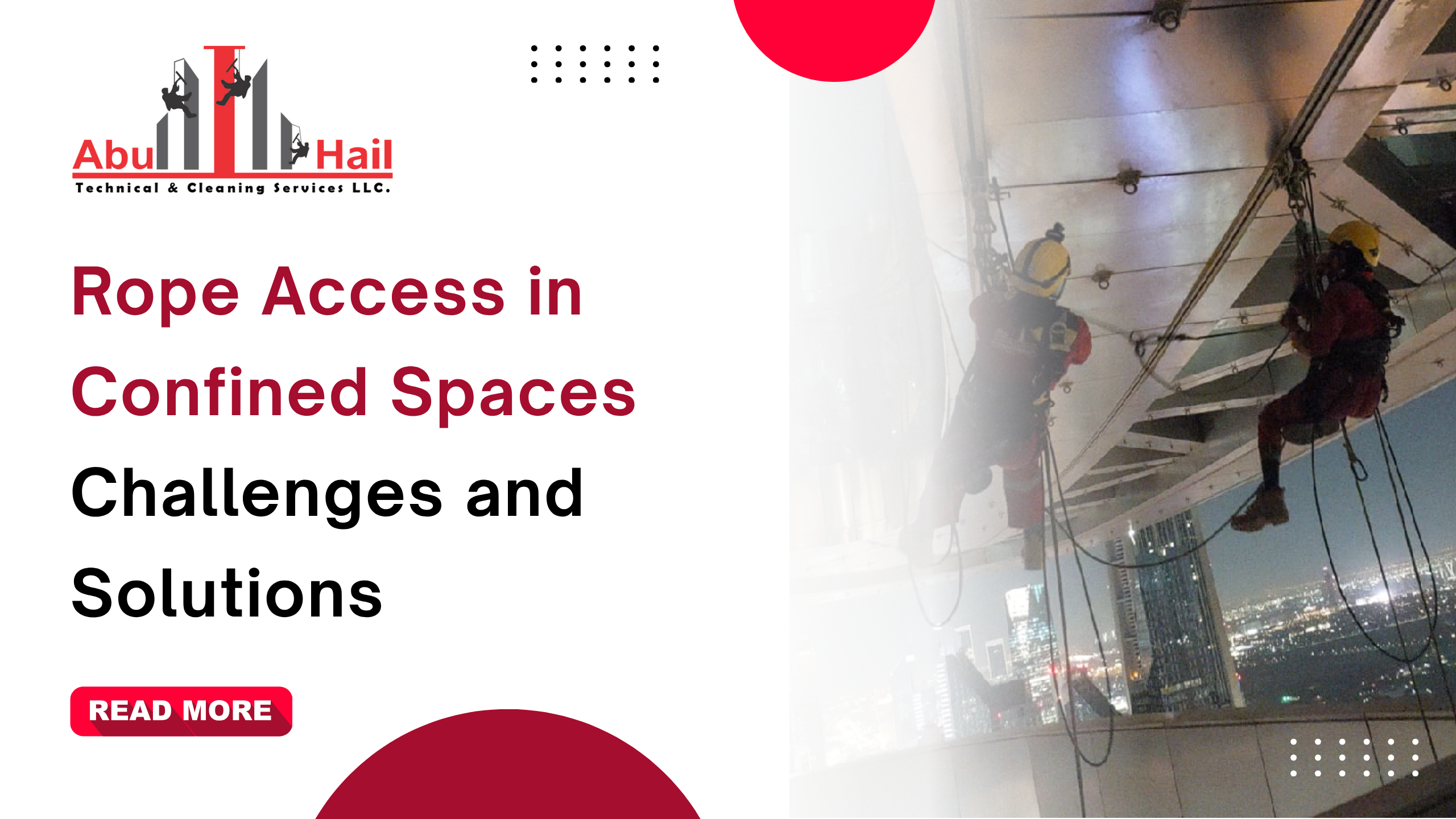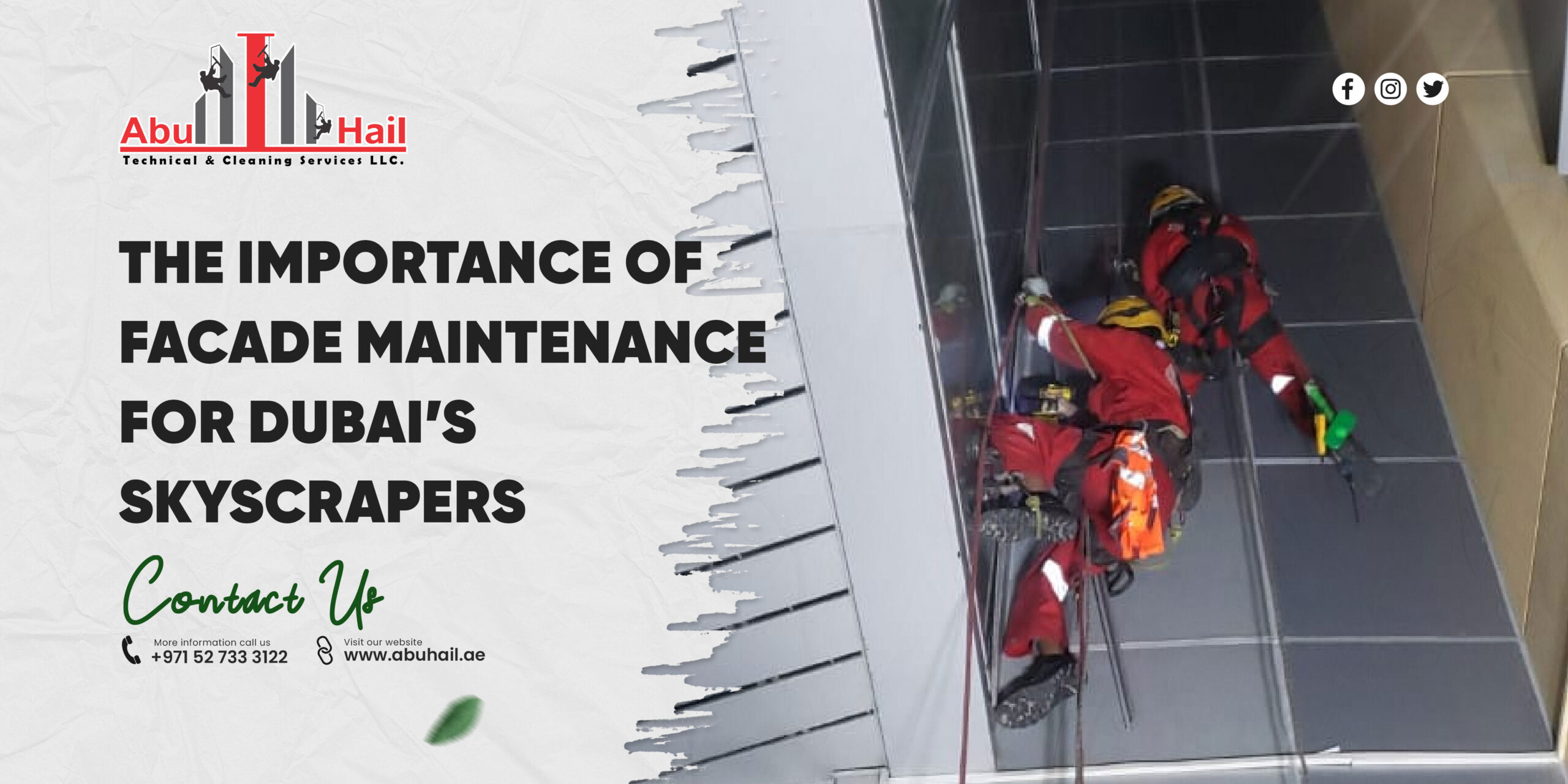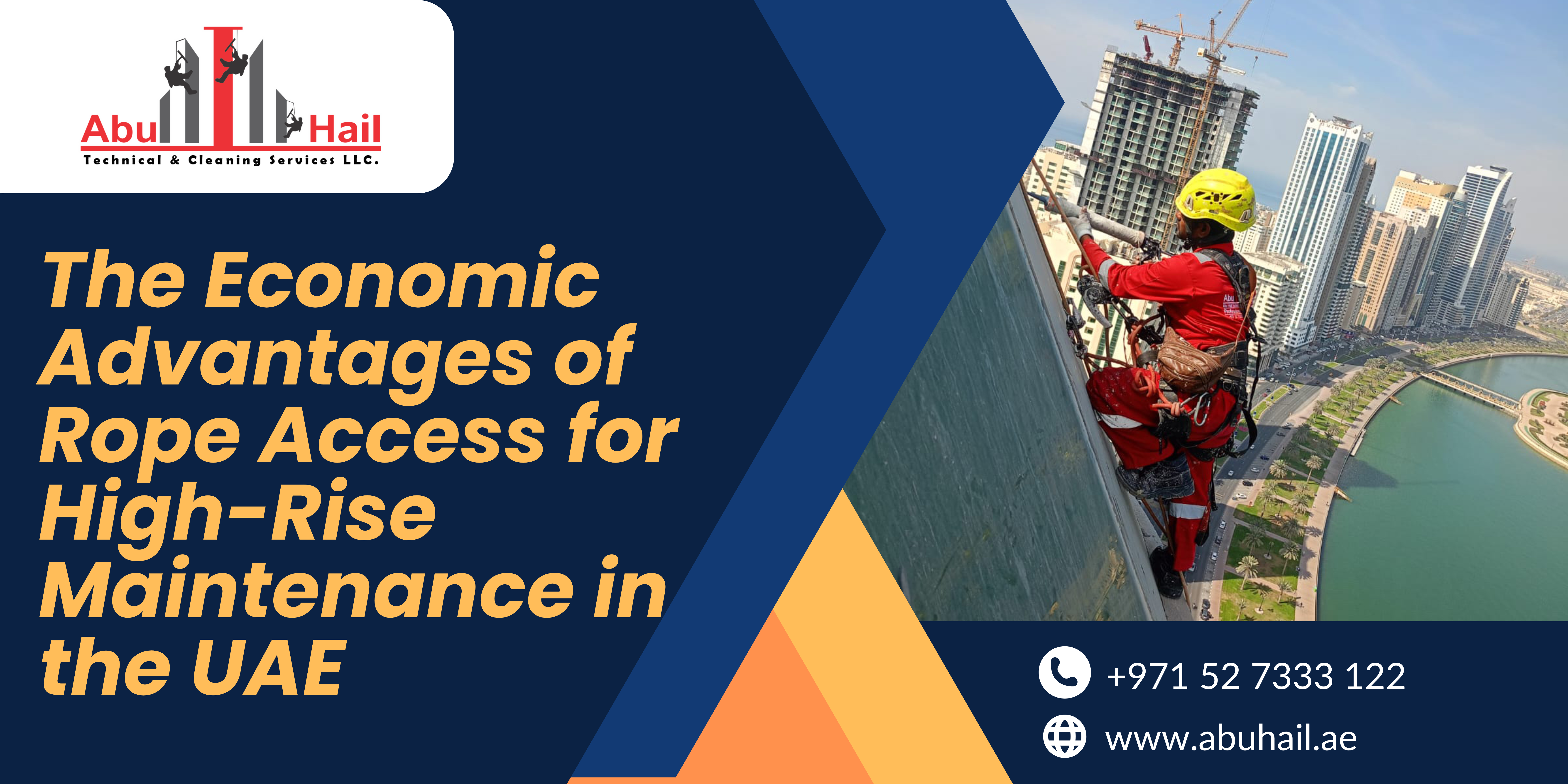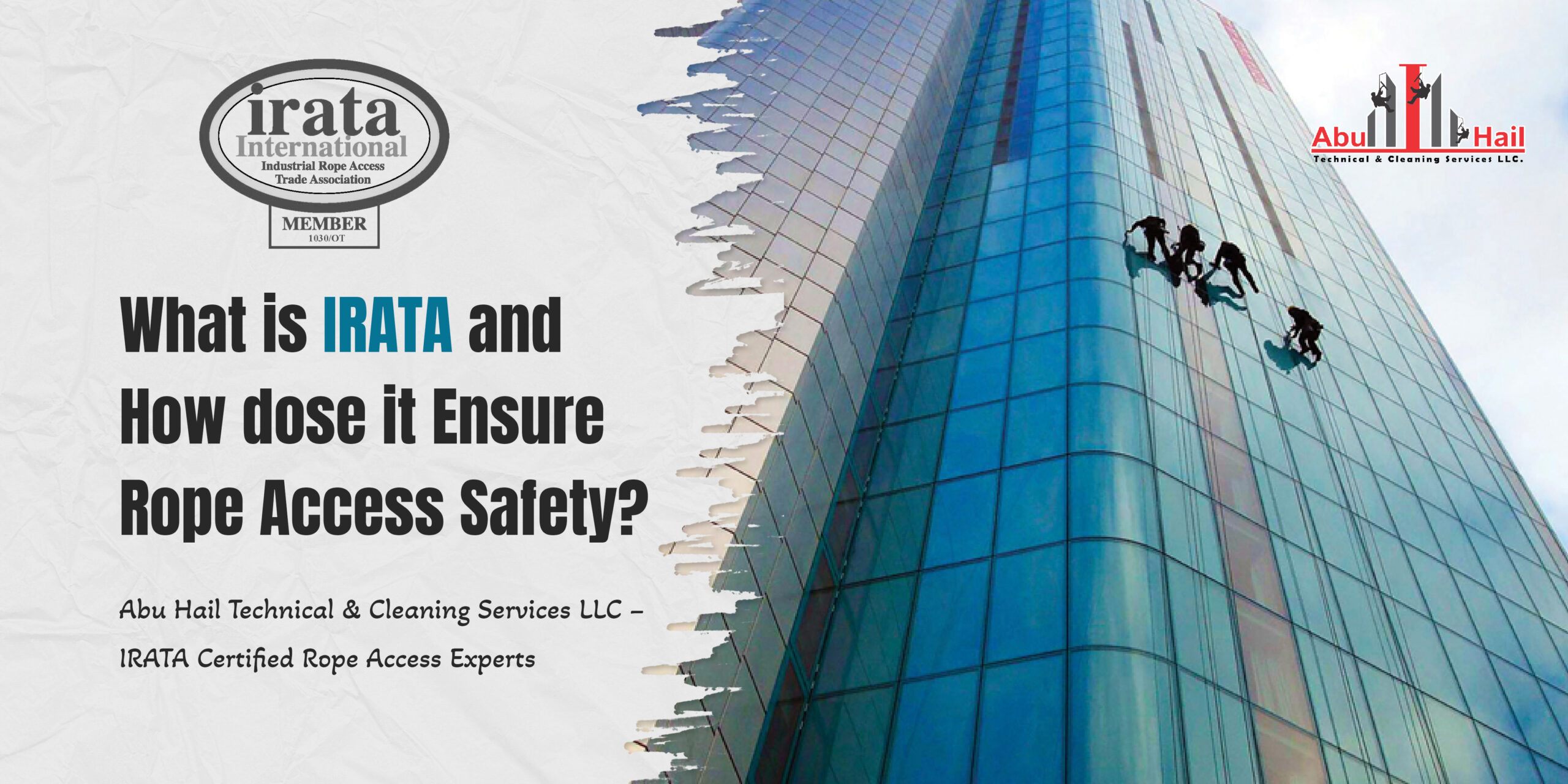
Rope Access in Confined Spaces
Rope access has revolutionized the way maintenance, inspection, and repair work is performed at heights. While it is widely used for high-rise facades, offshore platforms, and industrial structures, rope access is increasingly being applied to confined spaces—areas that are difficult to reach, hazardous, or extremely tight. Confined space rope access requires a unique combination of expertise, equipment, and planning to ensure the safety of technicians while maintaining operational efficiency.
In this article, we will explore the challenges of rope access in confined spaces, innovative solutions to overcome these obstacles, safety best practices, and why Abu Hail Technical & Cleaning Services is a trusted leader in this field in Dubai and across the UAE.
1. Introduction to Rope Access in Confined Spaces
Rope access in confined spaces involves performing work in areas where entry and movement are restricted due to size, layout, or structural constraints. Examples include:
- Industrial tanks, silos, and chimneys
- Rooftops and atriums with restricted access
- Offshore platforms and ship hulls
- Underground shafts, tunnels, and pipelines
These areas often present a combination of risks such as limited ventilation, poor visibility, slippery surfaces, and potential exposure to hazardous chemicals. Traditional access methods like scaffolding or cranes are usually impractical in these environments, making rope access the preferred solution.
2. Importance of Confined Space Rope Access
Confined space rope access is critical for several reasons:
- Efficiency: Rope access allows technicians to reach tight spaces quickly without extensive scaffolding setup.
- Safety: Proper rope access methods minimize the risk of falls, slips, or accidents in restricted areas.
- Cost-Effectiveness: Reduced need for heavy machinery and labor translates into lower operational costs.
- Versatility: Technicians can perform inspections, repairs, painting, and cleaning in spaces otherwise inaccessible.
By leveraging rope access for confined spaces, organizations can ensure maintenance tasks are completed on time, safely, and with minimal disruption.
3. Common Challenges in Confined Space Rope Access
Working in confined spaces presents unique challenges that require careful planning and execution:
3.1 Limited Mobility
Restricted space limits the ability of technicians to move freely, increasing the risk of fatigue and accidents. Maneuvering ropes, harnesses, and tools becomes more difficult, especially in vertical or angled shafts.
3.2 Poor Visibility
Confined spaces often lack natural light, making visibility a challenge. Technicians must rely on portable lighting, headlamps, and sensors to perform accurate inspections and repairs.
3.3 Hazardous Atmospheres
Confined spaces may contain harmful gases, dust, or chemicals that pose health risks. Proper ventilation and monitoring equipment are essential to prevent exposure.
3.4 Equipment Constraints
Traditional rope access equipment may not fit or operate efficiently in tight areas. Specialized compact tools, harnesses, and anchors are required for effective performance.
3.5 Emergency Evacuation Challenges
In the event of an accident or medical emergency, evacuating personnel from confined spaces can be difficult. Pre-planned rescue procedures are crucial for safety.
4. Specialized Equipment for Confined Spaces
Rope access in confined spaces requires a range of specialized equipment designed to optimize safety and efficiency:
4.1 Compact Harnesses and Fall Arrest Systems
Technicians use harnesses that are lightweight, flexible, and ergonomically designed for restricted movement. Fall arrest systems are integrated to prevent accidents in vertical or inclined spaces.
4.2 Rope and Anchor Systems
High-strength synthetic ropes with low stretch and UV resistance are preferred. Compact anchor systems allow secure attachment without occupying excessive space.
4.3 Lighting and Visibility Tools
Portable LED lights, helmet-mounted headlamps, and reflective markers enhance visibility in dark or poorly lit spaces.
4.4 Ventilation and Gas Detection Equipment
Portable ventilators, fans, and gas detectors ensure safe breathing conditions. This is critical in spaces where toxic gases or low oxygen levels may be present.
4.5 Compact Tools and Devices
Small, lightweight tools such as mini grinders, inspection cameras, and portable cleaning devices allow technicians to perform tasks efficiently without crowding the workspace.
5. Advanced Safety Measures and Protocols
Safety is the top priority in confined space rope access. Some of the most important safety measures include:
5.1 Risk Assessment
Before starting any work, a thorough risk assessment identifies hazards such as chemical exposure, structural weaknesses, or limited egress points.
5.2 Permit-to-Work Systems
A permit-to-work system ensures that all safety checks, equipment, and personnel requirements are met before work begins.
5.3 Continuous Monitoring
Technicians use sensors to monitor air quality, oxygen levels, and structural integrity in real-time, ensuring immediate response to potential hazards.
5.4 Rescue Planning
Confined space rope access teams always have a rescue plan in place, including backup personnel, rescue ropes, and first aid equipment.
5.5 Communication Systems
Two-way radios, helmet intercoms, and signaling systems keep technicians in constant contact with supervisors outside the confined space.
6. Planning and Risk Assessment for Confined Space Work
Proper planning is essential for successful rope access operations in confined spaces:
Site Survey: Inspect the site to identify hazards and determine access points.
Task Analysis: Define tasks to be performed, required tools, and equipment.
Personnel Allocation: Assign trained technicians with experience in confined spaces.
Timeline Planning: Estimate time for task completion, including safety checks and emergency contingencies.
Documentation: Maintain records of risk assessments, permits, and safety procedures.
Thorough planning ensures that operations are executed efficiently, minimizing downtime and reducing the risk of accidents.
7. Training and Certification for Confined Space Technicians
Technicians working in confined spaces must undergo specialized training and certification:
7.1 Rope Access Certification
Organizations like IRATA (Industrial Rope Access Trade Association) and SPRAT (Society of Professional Rope Access Technicians) provide certified training programs in rope access techniques.
7.2 Confined Space Safety Training
Technicians learn about hazard identification, safe entry procedures, ventilation, and emergency evacuation in confined environments.
7.3 Equipment Handling
Training includes the proper use of compact tools, lighting, ropes, and anchors in tight spaces.
Benefits of Proper Training:
Reduces the likelihood of accidents
Increases efficiency and confidence
Ensures compliance with UAE safety regulations
8. Real-World Applications and Case Studies
Confined space rope access is applied across various industries:
8.1 Industrial Tanks and Silos
Rope access teams clean, inspect, and repair storage tanks and silos, ensuring structural integrity and preventing contamination.
8.2 Offshore Platforms
Technicians perform inspection and maintenance in confined areas of oil rigs and offshore structures, using specialized equipment to navigate tight spaces safely.
8.3 High-Rise Buildings
In atriums, service shafts, and rooftop enclosures, rope access allows technicians to clean facades, inspect HVAC systems, and repair structures without scaffolding.
8.4 Tunnels and Underground Pipelines
Rope access enables maintenance teams to safely inspect tunnels, pipelines, and underground conduits that are otherwise difficult to access.
9. Technological Innovations in Confined Space Rope Access
Several technological advancements have improved safety and efficiency in confined space rope access:
9.1 Compact Robotics
Small robots can perform inspections, clean surfaces, or assist in repairs in areas too tight for human access.
9.2 Drones for Preliminary Inspections
Mini drones equipped with cameras can navigate confined spaces to provide a visual assessment before sending technicians in.
9.3 Wearable Sensors
Technicians now use wearable sensors that monitor vital signs, detect falls, and alert supervisors in real-time.
9.4 Software and Monitoring Systems
Project management and safety software allow supervisors to track operations, manage workflows, and monitor safety compliance remotely.
10. Advantages of Rope Access over Traditional Methods in Confined Spaces
Compared to scaffolding, ladders, or cranes, rope access offers distinct benefits in confined spaces:
Flexibility: Can access tight corners and vertical shafts with ease.
Speed: Faster setup and operation reduce project time.
Safety: Minimizes risk of falling objects and accidents.
Cost-Effective: Less equipment, labor, and space required.
Minimal Disruption: Works in operational areas without major interruptions.
11. Why Choose Abu Hail Technical & Cleaning Services for Confined Space Work
Abu Hail Technical & Cleaning Services LLC is a leading provider of rope access solutions in Dubai and across the UAE. The company specializes in confined space operations, combining expertise, technology, and safety:
Expert Technicians: Certified IRATA and SPRAT professionals trained in confined space rope access.
Advanced Equipment: Lightweight harnesses, compact tools, drones, and sensors for efficient operations.
Safety First: Comprehensive risk assessments, monitoring, and rescue plans ensure zero compromise on safety.
Proven Track Record: Successfully completed industrial, offshore, and high-rise confined space projects.
Sustainability: Eco-friendly cleaning agents and minimal equipment usage reduce environmental impact.
With Abu Hail, clients can be confident that even the most challenging confined space tasks are performed safely, efficiently, and to the highest standards.
Rope access in confined spaces is a complex yet essential aspect of industrial, offshore, and high-rise maintenance. It requires specialized equipment, advanced safety measures, and highly trained technicians. While challenges like limited mobility, poor visibility, and hazardous atmospheres exist, innovations in rope access technology—such as compact robotics, drones, wearable sensors, and monitoring software—have transformed how confined space work is conducted.
By leveraging these technologies, organizations can improve operational efficiency, reduce costs, enhance safety, and achieve sustainability goals. Abu Hail Technical & Cleaning Services LLC exemplifies excellence in confined space rope access in Dubai and the UAE, offering clients a reliable, professional, and technologically advanced solution for even the most challenging environments.






